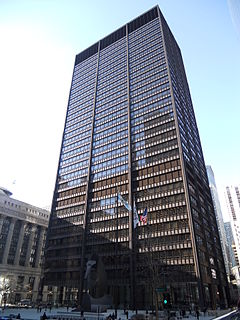In the United States, a state supreme court is the highest court in the state judiciary of a U.S. state. On matters of state law, the judgment of a state supreme court is considered final and binding in both state and federal courts.
In the United States, a state court has jurisdiction over disputes with some connection to a U.S. state. State courts handle the vast majority of civil and criminal cases in the United States; the United States federal courts are far smaller in terms of both personnel and caseload, and handle different types of cases.

A county court is a court based in or with a jurisdiction covering one or more counties, which are administrative divisions within a country, not to be confused with the medieval system of county courts held by the high sheriff of each county.

District courts are a category of courts which exists in several nations, some call them "small case court" usually as the lowest level of the hierarchy. These include:
The Kentucky Court of Appeals is the lower of Kentucky's two appellate courts, under the Kentucky Supreme Court. Prior to a 1975 amendment to the Kentucky Constitution the Kentucky Court of Appeals was the only appellate court in Kentucky.
The structure of the judiciary of Texas is laid out in Article 5 of the Constitution of Texas and is further defined by statute, in particular the Texas Government Code and Texas Probate Code. The structure is complex, featuring many layers of courts, numerous instances of overlapping jurisdiction, several differences between counties, as well as an unusual bifurcated appellate system at the top level found in only one other state: Oklahoma. Municipal Courts are the most active courts, with County Courts and District Courts handling most other cases and often sharing the same courthouse.
The Civil Court of the City of New York is a civil court of the New York State Unified Court System in New York City that decides lawsuits involving claims for damages up to $25,000 and includes a small claims part for cases involving amounts up to $5,000 as well as a housing part for landlord-tenant matters, and also handles other civil matters referred by the New York Supreme Court. It handles about 25% of all the New York state and local courts' total filings. The court has divisions by county (borough), but it is a single citywide court.
The Supreme Court of Appeals of West Virginia is the state supreme court of the state of West Virginia, the highest of West Virginia's state courts. The court sits primarily at the West Virginia State Capitol in Charleston, although from 1873 to 1915, it was also required by state law to hold sessions in Charles Town in the state's Eastern Panhandle. The court also holds special sittings at various locations across the state.

The Supreme Court of Georgia is the highest judicial authority of the U.S. state of Georgia. The court was established in 1845 as a three-member panel. Since 1896, the justices have been elected by the people of the state. The justices are currently elected in statewide non-partisan elections for six-year terms, with any vacancies filled through an appointment by the Governor.
The Judiciary of Colorado is established and authorized by Article VI of the Colorado Constitution as well as the law of Colorado. The various courts include the Colorado Supreme Court, Colorado Court of Appeals, Colorado district courts, Colorado county courts, Colorado water courts, and municipal courts. The administration of the state judicial system is the responsibility of the Chief Justice of the Colorado Supreme Court as its executive head, and is assisted by several other commissions. In Denver, the county and municipal courts are integrated and administratively separate from the state court system.

The Government of West Virginia is modeled after the Government of the United States, with three branches: the executive, consisting of the Governor of West Virginia and the other elected constitutional officers; the legislative, consisting of the West Virginia Legislature which includes the Senate and the House of Delegates; and the judicial, consisting of the West Virginia Supreme Court of Appeals and lower courts.

The Circuit Court of Cook County is the largest of the 24 judicial circuits in Illinois as well as one of the largest unified court systems in the United States — second only in size to the Superior Court of Los Angeles County since that court merged with other courts in 1998.

The Wisconsin circuit courts are the general trial courts in the state of Wisconsin. There are currently 69 circuits in the state, divided into 10 judicial administrative districts. Circuit court judges hear and decide both civil and criminal cases. Each of the 249 circuit court judges are elected and serve six-year terms.
The Unified Judicial System of Pennsylvania is the unified state court system of the Commonwealth of Pennsylvania.
The Ohio Courts of Common Pleas are the trial courts of the state court system of Ohio.
The Circuit Courts of Maryland are the state trial courts of general jurisdiction in Maryland. They are Maryland's highest courts of record exercising original jurisdiction at law and in equity in all civil and criminal matters, and have such additional powers and jurisdiction as conferred by the Maryland Constitution of 1867 as amended, or by law. The Circuit Courts also preside over divorce and most family law matters. Probate and estate matters are handled by a separate Orphans' Court. The Circuit Courts are the only Maryland state courts empowered to conduct jury trials.
The West Virginia Circuit Courts are the West Virginia state trial courts of general jurisdiction. They are the only state trial courts in West Virginia that are courts of record. West Virginia's 55 counties are divided into 31 circuits, each comprising anywhere from one to four counties. Different circuits have different numbers of judges; 11 circuits have only a single judge.
In West Virginia, magistrate courts are non-lawyer small claims and petty crime courts, established to replace the justice of the peace system in 1976. There are at least two magistrates in every county, and ten in the largest county, Kanawha. Magistrates have jurisdiction over civil cases in which the financial amount in dispute is less than ten thousand dollars. They hear misdemeanor cases and conduct preliminary examinations in felony cases. In criminal cases they issue and record affidavits, complaints, arrest warrants, and search warrants, as well as set bail and make decisions concerning proposed plea agreements, the collection of courts costs, cash bonds, and fines. Magistrates issue emergency protective orders in cases involving domestic violence.
The Judiciary of Virginia is defined under the Constitution and law of Virginia and is composed of the Supreme Court of Virginia and subordinate courts, including the Court of Appeals, the Circuit Courts, and the General District Courts. Its administration is headed by the Chief Justice of the Supreme Court, the Judicial Council, the Committee on District Courts, the Judicial Conferences, the Judicial Inquiry and Review Commission, and various other offices and officers.
The judiciary of Michigan is defined under the Michigan Constitution, law, and regulations as part of the Government of Michigan. The court system consists of the Michigan Supreme Court, the Michigan Court of Appeals as the intermediate appellate court, the circuit courts and district courts as the two primary trial courts, and several administrative courts and specialized courts. The Supreme Court administers all the courts. The Michigan Supreme Court consists of seven members who are elected on non-partisan ballots for staggered eight-year terms, while state appellate court judges are elected to terms of six years and vacancies are filled by an appointment by the governor, and circuit court and district court judges are elected to terms of six years.





